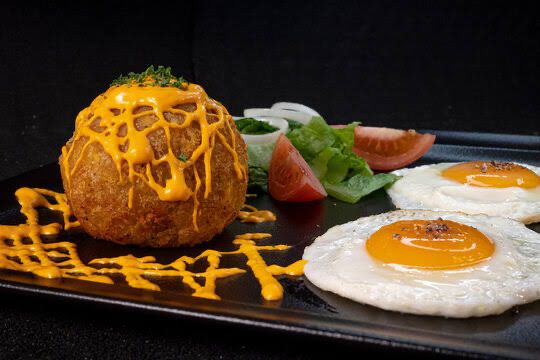Bolon: A Fascinating Journey Through the Cultural History and Unique Features of Ecuador's Staple Dish

Bolon is a dish that beautifully encapsulates the culinary traditions of Ecuador. Although there isn't a precise historical record of its origins, it's a dish whose roots extend deeply into the agricultural practices of the region.
Ecuador is located in a part of the world where plantains, the key ingredient in Bolon, are plentiful and have been a dietary staple for centuries. Plantains are similar to bananas but are larger, starchier, and less sweet. They're also much more versatile in cooking, being used in everything from appetizers to desserts.
Bolon specifically utilizes green plantains, which are unripe and therefore even more starchy. These plantains are typically boiled or fried until they become soft. They are then mashed and rolled into balls, which are usually filled with cheese or meat, and then deep-fried until they turn a delectable golden brown. The resulting texture is a lovely contrast between the crispy exterior and the soft, filling interior.
Bolon is incredibly popular in Ecuador, often served for breakfast or as a snack. Its popularity isn't confined to Ecuador, though. This delectable dish has found its way into other Latin American countries, each adding their own unique twist to the recipe.
In Ecuador, Bolon serves not only as a reflection of the country's agricultural abundance but also its cultural diversity. From the coastal regions to the Andean highlands, different variations of Bolon exist. Some variations incorporate seafood, a common ingredient in coastal regions, while others might include Andean cheese.
This fascinating dish, in its simplicity and versatility, represents Ecuador's unique cultural and agricultural landscape. It's a testament to the country's resourcefulness and the ability to create an immensely satisfying dish from basic, readily available ingredients. Indeed, the story of Bolon is not just about a dish, but a reflection of the people and culture of Ecuador itself.
The Art of Bolon: Exploring Variations and Masters of Ecuador's Signature Dish
The beauty of Bolon lies in its versatility, with different regions in Ecuador putting their unique spins on the dish. There's no single "correct" recipe for Bolon, and the number of variations is limited only by the creativity of the cook. Here are a few examples:
1. Bolon de Verde: This is the basic version of Bolon, using only green plantains and cheese. It's a favorite breakfast staple in many parts of Ecuador.
2. Bolon de Chicharron: This version includes chicharron, or fried pork rind, giving the Bolon a meaty flavor and a more diverse texture.
3. Bolon Mixto: As the name suggests, this Bolon version is a mix of different fillings, often including both cheese and some kind of meat, such as chicken or pork.
4. Bolon de Queso: This is a cheese-filled version of Bolon, usually featuring local Ecuadorian cheese. The cheese melts during the frying process, resulting in a creamy, savory center.
5. Bolon de Mariscos: In coastal regions of Ecuador, you might find Bolon filled with seafood, reflecting the local culinary traditions.
Each of these versions has its own merits and specific flavor profiles. This means that a journey through the various versions of Bolon can be a delicious exploration of Ecuador's diverse regional cuisines.
As for the "masters" of Bolon, there are many cooks and chefs in Ecuador who are celebrated for their Bolon. However, like many traditional dishes, some of the best versions are often found in local markets, small eateries, and family homes, where recipes have been perfected over generations. A famous place for bolon is the Montañita town, known for its oversized bolones, served as an all-day meal.
But the true mastery of Bolon lies in the hands of every Ecuadorian who has grown up with the dish and continues to make and share it, helping to preserve and promote a vital part of Ecuador's culinary heritage.



Comments ()